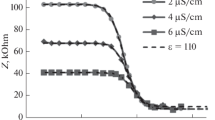Abstract
This paper reports on the analysis of dispersion in the imaginary part of impedance often observed at low frequencies in a variety of systems. The experimental data were obtained with an electrolytic cell containing KCl aqueous solution in the frequency range from 0.1 mHz to 10 MHz, where the use of ultra-low frequencies helps clarify the analysis of the imaginary impedance dispersion. It is shown that the low frequency dispersion described in the literature is the tail of a relaxation peak located at f ≅ 20 mHz. This ultra-low frequency dispersion peak is analyzed with a Cole-Cole impedance element, being associated with the electric double layer at the metal-electrolyte interface. Quantitative information can be extracted for the double layer, including its thickness (∼1 nm) and electrical resistivity (∼50 GΩm).




Similar content being viewed by others
References
J.R. Macdonald, W.B. Johnson, Impedance Spectroscopy (Wiley & Sons, New York, 1987)
F. Kremer, A. Schönhals (eds.), Broadband Dielectric Spectroscopy (Springer, Germany, 2003)
M. Becchi, C. Avendano, A. Stragazzi, G. Barbero, Impedance Spectroscopy of water solutions: the role of ions at the liquid-electrode interface. J. Chem. Phys. B 109, 23444–23449 (2005)
G. Barbero, L.R. Evangelista, Adsorption phenomena of neutral particles and a kinetic equation at the interface. Phys. Rev. E 70, 031605 (2004)
G. Barbero, Influence of adsorption phenomenon on the impedance spectroscopy of a cell of liquid. Phys. Rev. E 71, 062201 (2005)
G. Barbero, A.M. Figueiredo Neto, F.C.M. Freire, M. Scarlerandi, Frequency dependence of the electrical impedance of electrolytic cells: the role of the ionic adsorption/desorption phenomena and the Stern layer. Phys. Lett. A 360, 179–182 (2006)
G. Barbero, M. Becchi, A. Stragazzi, J. Le Digabel, A.M. Figueiredo Neto, Experimental evidence for the adsorption-desorption phenomenon of the spectroscopy impedance measurements of an electrolytic cell. J. Appl. Phys. 101, 044102 (2007)
G. Derfel, G. Barbero, Numerical study of ionic contribution to susceptibility and impedance of dielectric layer. J. Mol. Liq. 150, 43–50 (2009)
G. Barbero, F. Batalioto, A.M. Figueiredo Neto, Impedance spectroscopy of an electrolytic cell limited by ohmic electrodes. J. Appl. Phys. 101, 054102 (2007)
D.M. Taylor, A.G. MacDonald, AC admittance of the metal-insulator-electrolyte interface. J. Phys. D. Appl. Phys. 20, 1277–1283 (1987)
J.-B. Jorcim, M.E. Orazem, N. Pebere, B. Tribollet, CPE analysis by local electrochemical impedande spectroscopy. Electrochim. Acta 51, 1473–1479 (2006)
W.G. Pell, A. Zolfaghari, B.E. Conway, Capacitance of the double-layer at polycrystalline Pt electrodes bearing a surface-oxide film. J. Electroanal. Chem. 532, 13–23 (2002)
E.K. Lenzi, J.L. de Paula, F.R.G.B. Silva, L.R. Evangelista, A connection between anomalous Poisson-Nernst-Planck model and equivalent circuits with constant phase elements. J. Chem. Phys. C 117, 23685–23690 (2013)
A.R. Duarte, F. Batalioto, G. Barbero, A.M. Figueiredo Neto, Measurement of the impedance of aqueous solutions of KCl: an analysis using an extension of Poisson-Nernst-Planck model. Appl. Phys. Lett. 105, 022901 (2014)
A.R. Duarte, Ph.D. Thesis, São Paulo University, Brazil (2015)
As described in the 1260A Impedance Analyzer operating manual
Scribner and Associates, Inc., Charlottesville, VA, USA
R.H.M. van de Leur, A critical consideration on the interpretation of impedance plots. J. Phys. D. Appl. Phys. 24, 1430–1435 (1991)
J.R. Macdonald, Comparison and evaluation of several models for fitting the frequency response of dispersive systems. J. Chem. Phys. 118, 3258–3267 (2003)
J.R. Macdonald, Analysis of dielectric and conductive dispersion above Tg in glass-forming molecular liquids. J. Chem. Phys. 112, 13684–13694 (2008)
K.J. Woelfel, J.E. Pemberton, Determination of emersed electrochemical interface thickness by ellipsometry: aqueous electrolytes on Ag. J. Electroanal. Chem. 456, 161–169 (1998)
J.B. Bates, Y.T. Chu, W.T. Stribling, Surface topography and impedance of metal-electrolytic interfaces. Phys. Rev. Lett. 60, 627–630 (1988)
F. Pizzitutti, F. Bruno, Electrode and interfacial polarization in broadband dielectric spectroscopy measurements. Rev. Sci. Instrum. 72, 2502–2504 (2001)
V.M.-W. Huang, V. Vivier, M.E. Orazem, N. Pébère, B. Tribollet, The apparent constant-phase-element behavior of a disk electrode with faradaic reactions—a global and local impedance analysis. J. Electrochem. Soc. 154, C81–C88 (2007)
F. Batalioto, A.R. Duarte, G. Barbero, A.M. Figueiredo Neto, Dielectric dispersion of water in the frequency range from 10 mHz to 30 MHz. J. Phys. Chem. B 114, 3467–3471 (2010)
K.J. Woefel, J.E. Pemberton, Determination of emersed electrochemical interface thickness by ellipsometry: aqueous electrolytes on Ag. J. Electroanal. Chem. 456, 161–169 (1998)
J.R. Macdonald, Utility of continuum diffusion models for analyzing mobile-ion immittance data: electrode polarization, bulk, and generation-recombination effects. J. Phys. Condens. Matter 22, 495101 (2010)
J.R. Macdonald, Utility and importance of Poisson-Nernst-Planck imittance spectroscopy fitting models. J. Chem. Phys. C 117, 23433–23450 (2013)
E.K. Lenzi, M.K. Lenzi, F.R.G.B. Silva, G. Gonçalves, R. Rossato, R.S. Zola, L.R. Evangelista, A framework to investigate the immittance responses for finite length-situations: fractional diffusion equation, reaction term, and boundary conditions. J. Electroanal. Chem. 712, 82–88 (2014)
Acknowledgments
The authors would like to thank the Brazilian foundations FAPESP, CNPq, INEO Project, and CAPES for the financial support and to O. Oliveira Jr. for revising the manuscript.
Author information
Authors and Affiliations
Corresponding author
Rights and permissions
About this article
Cite this article
Giacometti, J.A., Alves, N. & Teruya, M.Y. Impedance of Aqueous Solutions of KCl at the Ultra-low Frequency Range: Use of Cole-Cole Impedance Element to Account for the Frequency Dispersion Peak at 20 mHz. Braz J Phys 46, 50–55 (2016). https://doi.org/10.1007/s13538-015-0381-4
Received:
Published:
Issue Date:
DOI: https://doi.org/10.1007/s13538-015-0381-4




